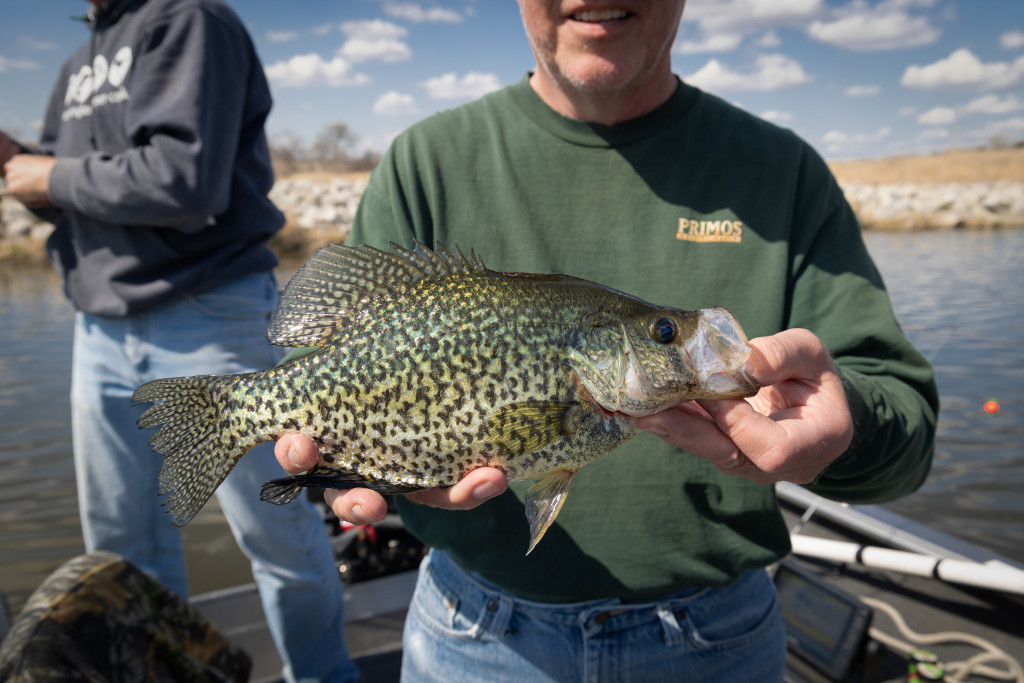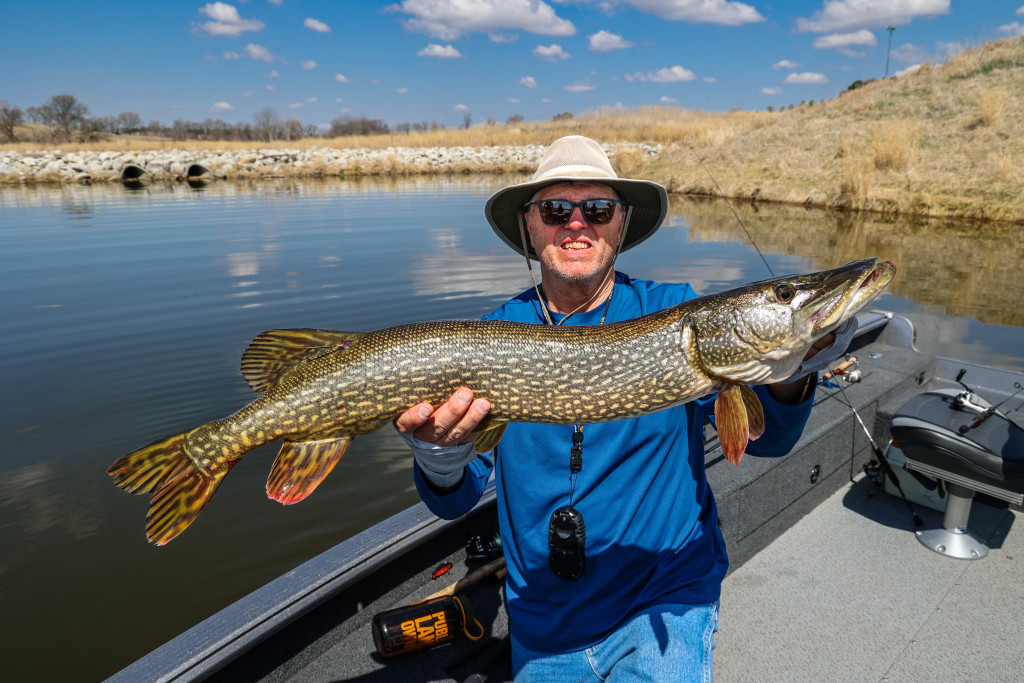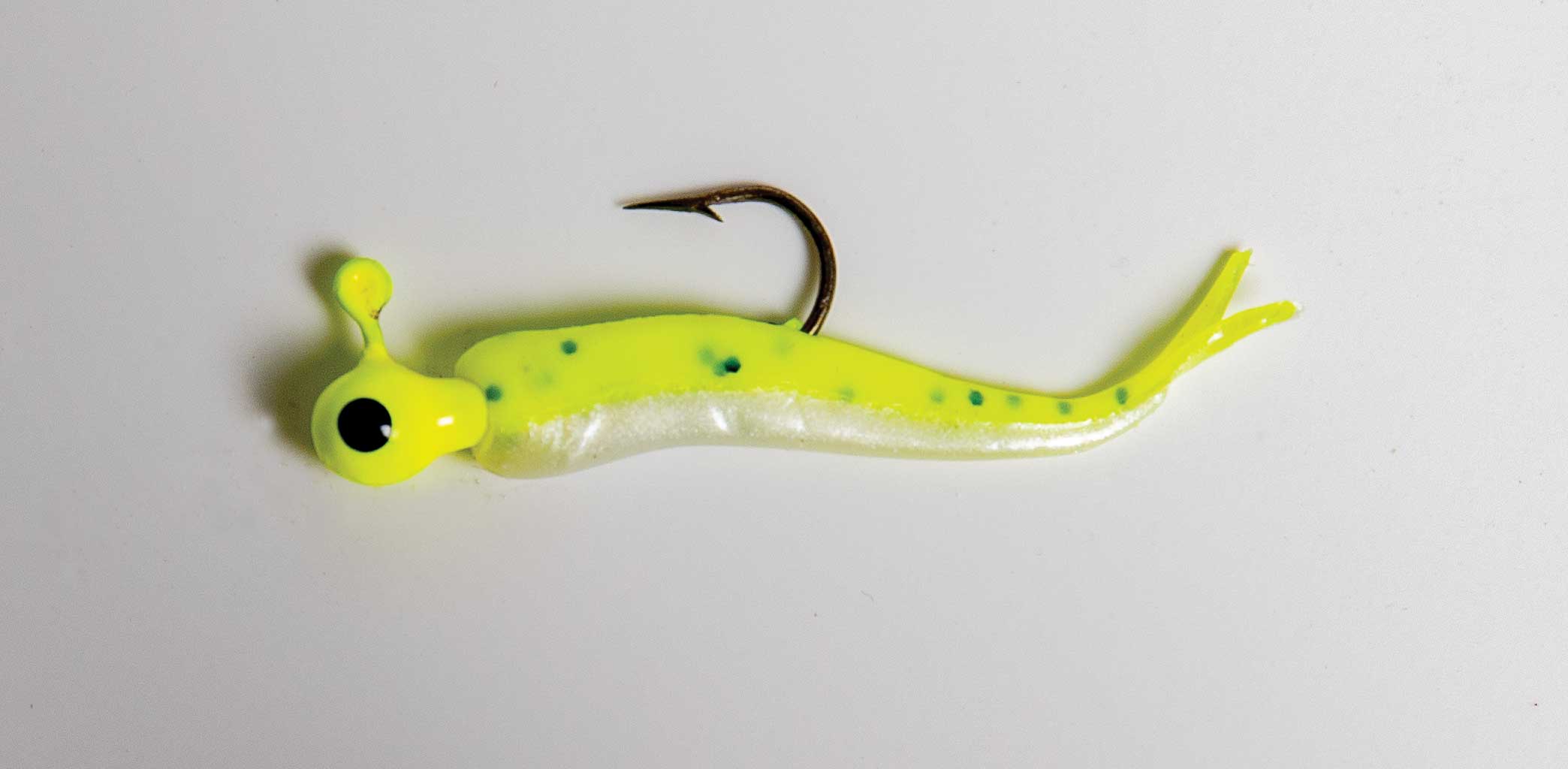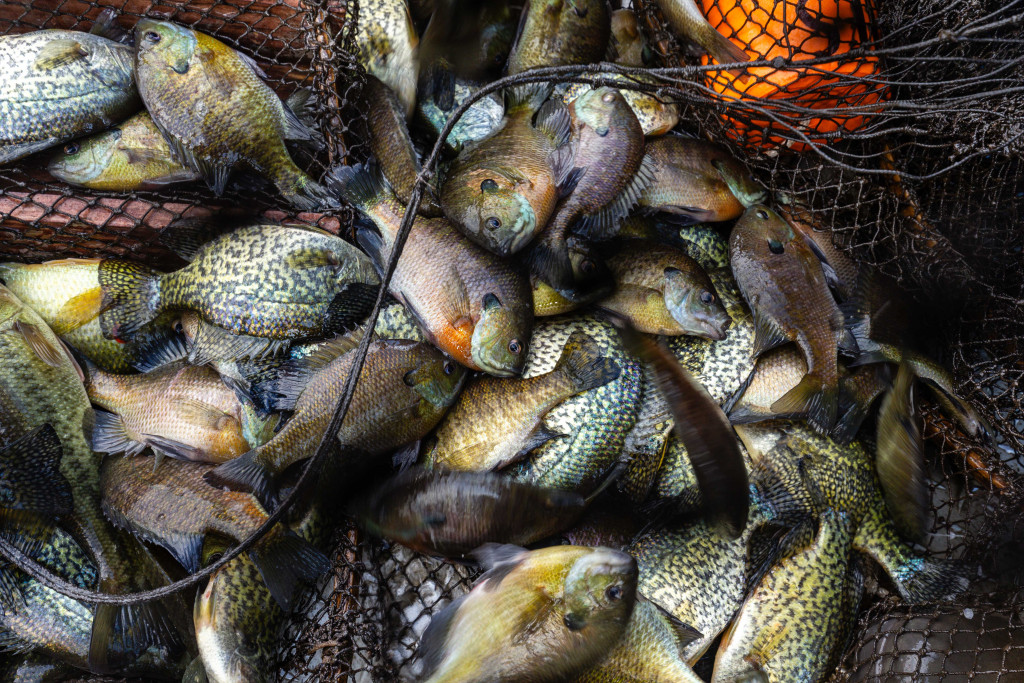Flanagan Lake in Omaha offers anglers action-packed fishing in the spring.
Enlarge

Photo by Jenny Nguyen-Wheatley
Story and photos by Jenny Nguyen-Wheatley
“You call this a lake?” said my friend Hank Shaw as we unloaded out of the truck on a weekday morning in April. From the southwest parking lot near Fort and 168th streets, Flanagan Lake in Omaha looked little more than a pond. Hank didn’t know that the rest of the lake was obscured, and I had forgotten it. The last time I was here, the lake hadn’t been filled with water — construction of Flanagan began in 2015 and finished in 2017.
Accustomed to ocean fishing along the coast of California and Mexico — even commercial salmon fishing in Alaska — Hank, then of Sacramento, California, scoffed at the new-ish metro construction located just 15 minutes west from our house. I chuckled sheepishly in response, not knowing if I had blown my chance to impress a visitor or if it was just Hank’s sense of West Coast superiority teasing.
Our guide Dean Thielen of DAB Fishing was already on the lake. He waved to us from his Lund, and after customary introductions near the boat ramp, the four of us began flinging Gulp! minnows across the water. We worked the deeper, south end of Flanagan near the dam first, slowly floating back north toward the boat ramp and kayak launch.

Dean was informative, but not pedantic in his instruction. And just because an angler might be a master on saltwater, doesn’t mean they will instinctively know what to do on freshwater, and vice versa. Dean reeled in several nice crappie with practiced hands before Hank landed a four-inch “ditch pickle” — a largemouth bass — his first fish of 2023. My husband, Rick, followed up with a crappie. And I wouldn’t catch my first fish — a crappie — until several moments later.
As expected during that time of year, the fish would be lethargic at that deeper, colder end of Flanagan. So, we abandoned that south side and trolled up toward the north end, and that’s where the waterscape opened up.
“Whoa, this lake is a lot bigger than I thought,” Hank admitted, sitting back and admiring the view and soaking in the warmth of the spring sun.
For a metro-area lake, 225 acres of surface water at full pool isn’t half bad. The surrounding land adds an additional 505 acres of green space, a playground and park area on the northeastern side south of Ida Street, and over 5 miles of paved trails. Despite being located in the middle of the city and surrounded by homes, our time on the water was peaceful. We delighted over the myriad of songbirds and waterfowl that zoomed close as the boat slowly made its way through the submerged trees that dotted the length of the lake, which provided fish structure.

At the north end of Flanagan, a wetland area could be credited for much of the avian life we witnessed. Although the wetland was primarily constructed to slow down water and prevent siltation of the reservoir, it also functions as a great place for wildlife viewing, said Game and Parks southeast district fisheries supervisor Aaron Blank.
Dean took us under the Ida overpass and to the very north end of Flanagan, where his boat could go no farther past the wetland. There, shallow water warmed by the sun created the ideal conditions for active, hungry fish, and during the next several hours, picture-perfect, spring-fishing fun ensued. We fished until 4 o’clock that day, steadily hooking into more than 100 fish: loads of nice black crappie — one possible Master Angler-worthy specimen caught by Hank, several impressive largemouth bass, some bluegill, one channel catfish and a beautiful northern pike caught by Dean.
When we set out that morning, we’d agreed to only catching and releasing fish, but by 3 p.m., Hank decided he was hungry for a fish fry. So, we started throwing some crappie in the livewell, which didn’t take long to accomplish, considering how late in the day it was. We also threw back several fish over the maximum length of 10 inches, a special regulation that is unique not only to Nebraska but also to the country (read sidebar below).

On the way home, we stopped by Walmart to pick up a pack of Louisiana Fish Fry, frozen french fries and a case of Pabst Blue Ribbon. I cooked our fish dinner on the back deck that evening. It was nothing fancy — just good Nebraska eating to end a productive spring day on the water.
Flanagan took us all by surprise.
The Nebraska Game and Parks Commission manages the fishery at Flanagan Lake. The City of Omaha maintains the lake’s facilities. The Papio-Missouri River Natural Resource District operates the reservoir.
How to Fish Flanagan Throughout the Year
By Dean Thielen
Bait
The No. 1 bait for multiple species of fish is a jig and a plastic, using different sizes for the different species of fish. With bluegill, use a 1⁄64-ounce jig with 1-inch Gulp! minnow.
For crappie, move to a 1⁄32-ounce. For bass, throw a Ned rig, a mushroom jig tipped with a short plastic worm or creature. For crappie and other panfish, simply put a jig and a bobber about a foot, 2 feet or 3 feet above that, depending on the kind of habitat you’re fishing. You just twitch it back slowly.
Pike and bass might want something with more aggressive action, like a spinner. Crankbaits certainly work. Overall, I find plastics and jigs to be much more effective in this part of the country than crankbaits and spinnerbaits because of what the food source is in Flanagan. The jig will catch every fish in the lake, including catfish. We’ve caught 36-inch pike on 1-inch Gulp! minnows.

Early Spring
When the water starts to warm up in April, occasionally in March, fish will typically start to move into the shallow coves and shallow bays and stay there starting April through May. There’s a lot of habitat in Flanagan, especially right in the bay down from the boat ramp at the cove. There will be a lot of fish there starting in April and through May and a little bit into June.
Late Spring
After that, the fish will move out to their summertime location to spawn. The crappie will spawn in May. The bass will spawn at the end of May. The bluegill spawn in June. Spawning areas will be along the rocks and riprap at the end of May and into June. And they’ll also be along the bottom of some of those flats.
Summer
After the spawn, figure out where food is located. A lot of the food will be along the weed edges. So, if you’re fishing from shore on Flanagan, it will be tough during the summertime because the weeds get thick. When temperatures get hot, usually in July and August, the weeds start dying off, and then shoreline fishing gets good again. But if you’re out on a boat, focus on weed edges because a lot of fish will be there.
Flanagan also has a lot of timber. When temperatures rise in the summer, the shade provided by timber becomes valuable. Big horizontal logs are better than vertical logs because they’ll provide a lot more shade.
Fall
After that, it’s basically looking at what the food source is doing and what’s going on with the weeds. The remaining vegetation will hold some weeds into the fall, and as it totally dies off, so do the bug hatches. So, the fish might move into the trees again if the trees are providing cover and food. That can vary a little bit, but not a lot. Spots that are good one year are typically going to be good the next year.
Why Special Regs at Flanagan?
By Jacob Werner, Fisheries Biologist
The Nebraska Game and Parks Commission began implementing a 10-inch maximum length limit for crappie and 8-inch maximum length limit for bluegill and redear sunfish at Flanagan Lake on Jan. 1, 2023. These limits are not only unique to Nebraska, but as far as we know, are unique to the country. The ultimate goal is to create a “trophy” fishery.
Crappie in southeastern Nebraska tend to hit a growth bottleneck at around 8-10 inches, where they stack up in that range with few pushing past the bottleneck to larger sizes. Similarly, bluegill tend to stack up in the 6- to 8-inch range, with few growing larger than 8 inches.

The thinking behind the regulation is that by reducing the density of the most abundant size groups of crappie, bluegill and redear sunfish, we can increase the amount of resources available for the remaining fish in the water body to hopefully increase growth rates. And by releasing fish that are over the limit, we retain those larger fish in the water body.
So, we set up an experiment to test this hypothesis through regulation. We want to find out if we could push those fish populations into ones that have higher proportions of bigger fish.
The goal is for anglers to be able to regularly catch 9- to 10-inch bluegill and 13- to 15-inch crappie at Flanagan. We don’t know if the experiment will be successful, but we are optimistic. We are just one year into a five-year study, and we’ll continue to monitor the fishery and collect data to see how these regulations impact the fishery.
The post Fishing Flanagan – A Lake in the City appeared first on Nebraskaland Magazine.
















